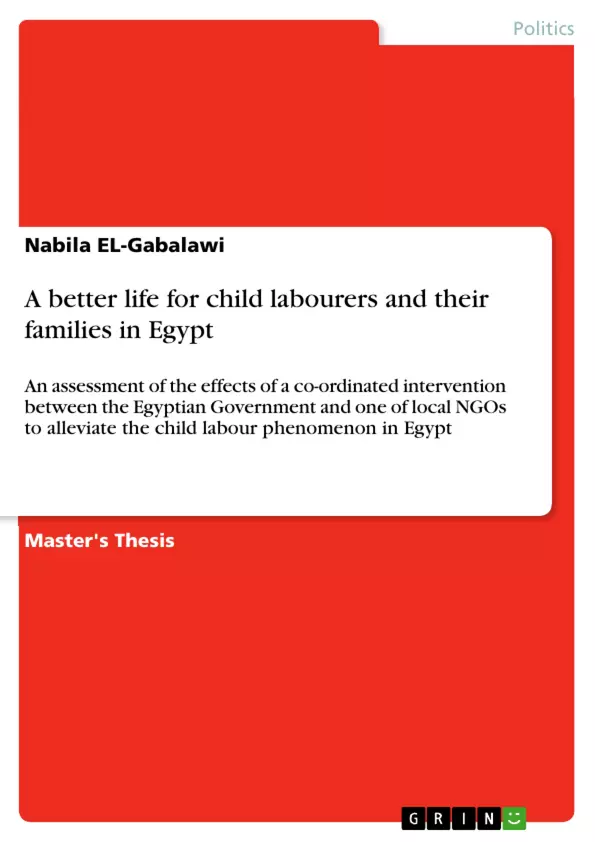The perception of child labour in Egypt like in any other place in the world has been changed dramatically in recent years. The current debates about child labour have conceived child labour as vital element for the survival of poor families. Most of the traditional interventions were focusing on combating child labour with no consideration to the living circumstances of the child labourers, controversially the new approaches by different national and international stakeholders started to adjust their interventions to be appealing to the circumstances of child labourers and their families.
The main theme of this dissertation is to examine the effectiveness of one of these interventions and its sustainability. For that purpose, a field research in Cairo, the capital of Egypt has been conducted. The aim of the field research is to analyse one of the interventions that implemented through coordination between the Egyptian Government through the National Council of Childhood and Motherhood and one of the Egyptian NGOs Abo Soud Social Development Association NGO. This Egyptian NGO carried out a child labour oriented project in partnership with an Italian NGO Cooperation Internazionale Sud Sud through Children at Risk Programme that funded by the European Union.
Using different quantitative and qualitative methodologies, the researcher tried to obtain the perception of child labourers and their families about the implemented activities in order to investigate whether the children’s rights and best interests were considered in the course of designing and implementing the activities of the project.
This dissertation challenges the argument that child labour became essential for the survival of poor families, thus it cannot be eradicated.
Through the assessed intervention, the researcher tried to investigate the effectiveness of the withdrawal of child labourers from the hazardous works, while poor people cannot survive without child labour. The researcher tried also to examine the sustainability of the provision of financial support for child labourers’ families as a solution to reduce the incidence of child labour. Moreover, education as one alternative to reduce child labour was assessed.
It was argued through the study that none of the interventions, which directed to enhance the livelihoods of child labourers and their families as well as children’ working conditions, would be sustainable unless the children’s needs, rights and best interests are endorsed.
Table of Contents
- 1. Einleitung (Introduction)
- 1.1 Relevanz und Bedeutung von Medienkompetenz im Kontext von Bildung (Relevance and Significance of Media Literacy in the Context of Education)
- 1.2 Medienkompetenz als Schlüsselqualifikation für das 21. Jahrhundert (Media Literacy as a Key Qualification for the 21st Century)
- 1.3 Forschungsstand und Zielsetzung der Studie (Research Status and Objectives of the Study)
- 2. Theoretische Grundlagen (Theoretical Foundations)
- 2.1 Medienkompetenz – Definitionen und Modelle (Media Literacy – Definitions and Models)
- 2.2 Medienpädagogische Ansätze (Media Educational Approaches)
- 2.3 Medien und Bildung (Media and Education)
- 3. Empirische Untersuchung (Empirical Investigation)
- 3.1 Methodik und Design (Methodology and Design)
- 3.2 Stichprobe und Datenerhebung (Sample and Data Collection)
- 3.3 Datenanalyse (Data Analysis)
- 4. Ergebnisse (Results)
- 4.1 Mediennutzung und Medienkompetenz der Lernenden (Media Use and Media Literacy of Learners)
- 4.2 Die Rolle von Medien in der Schule (The Role of Media in School)
- 4.3 Faktoren, die die Medienkompetenz der Lernenden beeinflussen (Factors that Influence the Media Literacy of Learners)
- 5. Diskussion und Schlussfolgerungen (Discussion and Conclusions)
- 5.1 Zusammenfassung der Ergebnisse (Summary of Results)
- 5.2 Implikationen für die Praxis (Implications for Practice)
- 5.3 Zukunftsperspektiven (Future Perspectives)
Objectives and Key Themes
This study aims to investigate the media use and media literacy of learners in a specific context. The study explores the role of media in school and identifies factors that influence the media literacy of learners. The key themes of the study are:- Media Literacy
- Media Use
- Education
- School
- Factors Influencing Media Literacy
Chapter Summaries
Chapter 1 provides an introduction to the study, outlining the relevance and significance of media literacy in the context of education. It also establishes the research status and objectives of the study. Chapter 2 explores the theoretical foundations of media literacy, defining key concepts and examining different models and media pedagogical approaches. It also discusses the relationship between media and education. Chapter 3 details the methodology and design of the empirical investigation, describing the sample, data collection methods, and data analysis techniques employed in the study. Chapter 4 presents the results of the study, focusing on learners’ media use and media literacy levels. It examines the role of media in school and analyzes factors influencing learner media literacy.Keywords
The study focuses on the key terms and concepts of media literacy, media use, education, school, and factors that influence media literacy.- Citation du texte
- Nabila EL-Gabalawi (Auteur), 2008, A better life for child labourers and their families in Egypt, Munich, GRIN Verlag, https://www.grin.com/document/136049



